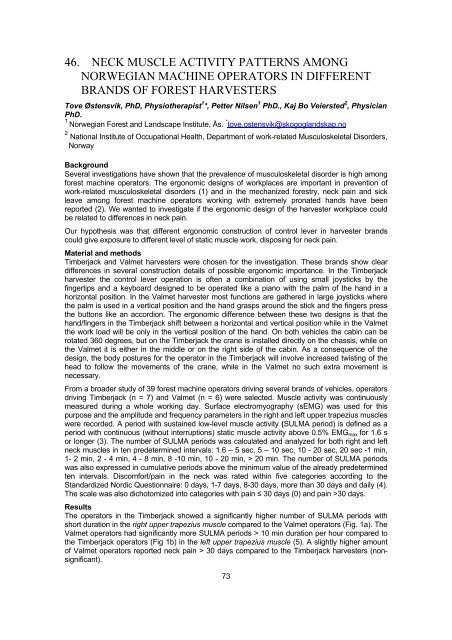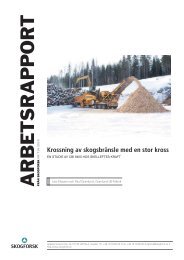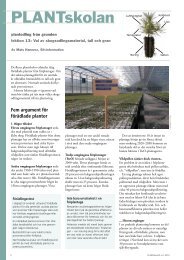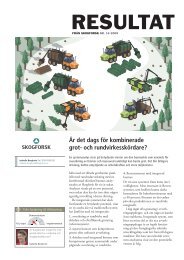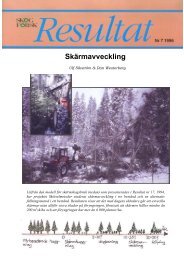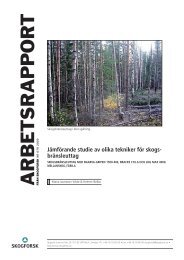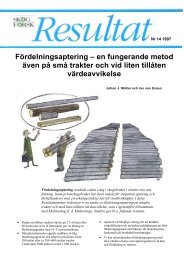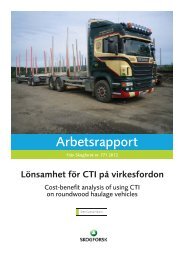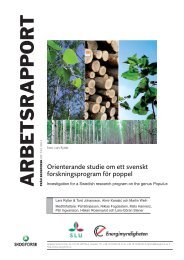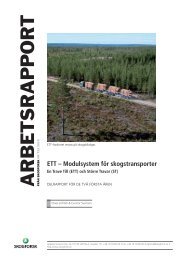Download pdf - Skog og landskap
Download pdf - Skog og landskap
Download pdf - Skog og landskap
Create successful ePaper yourself
Turn your PDF publications into a flip-book with our unique Google optimized e-Paper software.
46. NECK MUSCLE ACTIVITY PATTERNS AMONG<br />
NORWEGIAN MACHINE OPERATORS IN DIFFERENT<br />
BRANDS OF FOREST HARVESTERS<br />
Tove Østensvik, PhD, Physiotherapist 1 *, Petter Nilsen 1 PhD., Kaj Bo Veiersted 2 , Physician<br />
PhD.<br />
1 Norwegian Forest and Landscape Institute, Ås. * tove.ostensvik@sk<strong>og</strong><strong>og</strong><strong>landskap</strong>.no<br />
2 National Institute of Occupational Health, Department of work-related Musculoskeletal Disorders,<br />
Norway<br />
Background<br />
Several investigations have shown that the prevalence of musculoskeletal disorder is high among<br />
forest machine operators. The ergonomic designs of workplaces are important in prevention of<br />
work-related musculoskeletal disorders (1) and in the mechanized forestry, neck pain and sick<br />
leave among forest machine operators working with extremely pronated hands have been<br />
reported (2). We wanted to investigate if the ergonomic design of the harvester workplace could<br />
be related to differences in neck pain.<br />
Our hypothesis was that different ergonomic construction of control lever in harvester brands<br />
could give exposure to different level of static muscle work, disposing for neck pain.<br />
Material and methods<br />
Timberjack and Valmet harvesters were chosen for the investigation. These brands show clear<br />
differences in several construction details of possible ergonomic importance. In the Timberjack<br />
harvester the control lever operation is often a combination of using small joysticks by the<br />
fingertips and a keyboard designed to be operated like a piano with the palm of the hand in a<br />
horizontal position. In the Valmet harvester most functions are gathered in large joysticks where<br />
the palm is used in a vertical position and the hand grasps around the stick and the fingers press<br />
the buttons like an accordion. The ergonomic difference between these two designs is that the<br />
hand/fingers in the Timberjack shift between a horizontal and vertical position while in the Valmet<br />
the work load will be only in the vertical position of the hand. On both vehicles the cabin can be<br />
rotated 360 degrees, but on the Timberjack the crane is installed directly on the chassis, while on<br />
the Valmet it is either in the middle or on the right side of the cabin. As a consequence of the<br />
design, the body postures for the operator in the Timberjack will involve increased twisting of the<br />
head to follow the movements of the crane, while in the Valmet no such extra movement is<br />
necessary.<br />
From a broader study of 39 forest machine operators driving several brands of vehicles, operators<br />
driving Timberjack (n = 7) and Valmet (n = 6) were selected. Muscle activity was continuously<br />
measured during a whole working day. Surface electromy<strong>og</strong>raphy (sEMG) was used for this<br />
purpose and the amplitude and frequency parameters in the right and left upper trapezius muscles<br />
were recorded. A period with sustained low-level muscle activity (SULMA period) is defined as a<br />
period with continuous (without interruptions) static muscle activity above 0.5% EMG max for 1.6 s<br />
or longer (3). The number of SULMA periods was calculated and analyzed for both right and left<br />
neck muscles in ten predetermined intervals: 1.6 – 5 sec, 5 – 10 sec, 10 - 20 sec, 20 sec -1 min,<br />
1- 2 min, 2 - 4 min, 4 - 8 min, 8 -10 min, 10 - 20 min, > 20 min. The number of SULMA periods<br />
was also expressed in cumulative periods above the minimum value of the already predetermined<br />
ten intervals. Discomfort/pain in the neck was rated within five categories according to the<br />
Standardized Nordic Questionnaire: 0 days, 1-7 days, 8-30 days, more than 30 days and daily (4).<br />
The scale was also dichotomized into categories with pain ≤ 30 days (0) and pain >30 days.<br />
Results<br />
The operators in the Timberjack showed a significantly higher number of SULMA periods with<br />
short duration in the right upper trapezius muscle compared to the Valmet operators (Fig. 1a). The<br />
Valmet operators had significantly more SULMA periods > 10 min duration per hour compared to<br />
the Timberjack operators (Fig 1b) in the left upper trapezius muscle (5). A slightly higher amount<br />
of Valmet operators reported neck pain > 30 days compared to the Timberjack harvesters (nonsignificant).<br />
73


